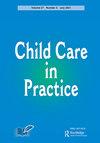(Re)assembling the Self: Homeless Young People’s Identity Journeys and the Search for Ontological Security
IF 1.4
Q3 FAMILY STUDIES
引用次数: 1
Abstract
ABSTRACT Homelessness is frequently assumed to be a fixed state that suspends people in time and space as they enter into contexts and environments where they struggle to exert control over their lives and their futures. Furthermore, a multitude of negative identities are ascribed to people who are homeless based on their lack of stable housing. A growing literature has contributed to a more nuanced understanding of the identity “work” engaged in by youth who experience homelessness. Nonetheless, most studies have examined the construction of identity cross-sectionally; in many cases, exclusively or primarily through the lens of youths’ experience of street and shelter life. Additionally, while the home has long since been argued to provide a secure base around which identities are constructed and ontological security attained, the intersection of identity with ontological security has, hitherto, not been adequately addressed within the youth homelessness literature. This paper examines the identity journeys of homeless young people based on selected findings from a six-year biographical longitudinal study of homeless youth in Dublin, Ireland. The analysis—which is organised according to the themes of rupture, the interruption of trust, and the (re)assembling of self—builds on existing studies by engaging with the concept of ontological security alongside an examination of young people’s accounts of, and reflections on, their journeys through and, in some cases, out of homelessness. The paper concludes by discussing the importance of understanding the identity stories of homeless youth through longitudinal biographical narration and addresses the policy implications arising from the findings presented.(重新)组装自我:无家可归的年轻人的身份之旅和对本体论安全的寻求
无家可归通常被认为是一种固定的状态,当人们进入他们努力控制自己的生活和未来的环境时,人们在时间和空间上暂停。此外,由于缺乏稳定的住房,无家可归的人被赋予了许多负面身份。越来越多的文献有助于更细致地理解无家可归的年轻人所从事的身份“工作”。尽管如此,大多数研究都是横向地考察了身份的构建;在许多情况下,完全或主要通过年轻人的街头和庇护所生活经验的镜头。此外,虽然家庭长期以来一直被认为提供了一个安全的基础,围绕着它构建身份并获得本体论安全,但迄今为止,在青少年无家可归的文献中,身份与本体论安全的交叉还没有得到充分的解决。本文根据对爱尔兰都柏林无家可归青年的六年传记纵向研究的选定结果,研究了无家可归青年的身份认同之旅。分析是根据破裂、信任中断和自我(重新)组装的主题组织的,它建立在现有研究的基础上,通过涉及本体论安全的概念,以及对年轻人的叙述和反思,他们经历无家可归的旅程,在某些情况下,走出无家可归。本文最后讨论了通过纵向传记叙事理解无家可归青年身份故事的重要性,并解决了所提出的研究结果所产生的政策影响。
本文章由计算机程序翻译,如有差异,请以英文原文为准。
求助全文
约1分钟内获得全文
求助全文
来源期刊

Child Care in Practice
Nursing-Community and Home Care
CiteScore
3.30
自引率
5.30%
发文量
32
期刊介绍:
Child Care in Practice is a quarterly, peer-reviewed journal that provides an international forum for professionals working in all disciplines in the provision of children’s services, including social work, social care, health care, medicine, psychology, education, the police and probationary services, and solicitors and barristers working in the family law and youth justice sectors. The strategic aims and objectives of the journal are: • To develop the knowledge base of practitioners, managers and other professionals responsible for the delivery of professional child care services. The journal seeks to contribute to the achievement of quality services and the promotion of the highest standards. • To achieve an equity of input from all disciplines working with children. The multi-disciplinary nature of the journal reflects that the key to many successful outcomes in the child care field lies in the close co-operation between different disciplines. • To raise awareness of often-neglected issues such as marginalization of ethnic minorities and problems consequent upon poverty and disability. • To keep abreast of and continue to influence local and international child care practice in response to emerging policy. • To include the views of those who are in receipt of multi-disciplinary child care services. • To welcome submissions on promising practice developments and the findings from new research to highlight the breadth of the work of the journal’s work.
 求助内容:
求助内容: 应助结果提醒方式:
应助结果提醒方式:


